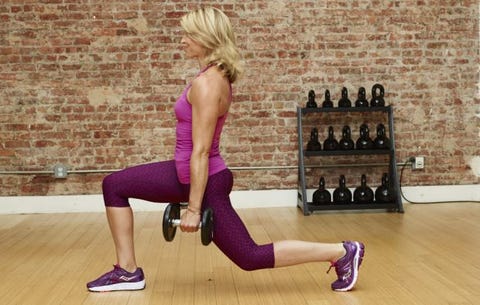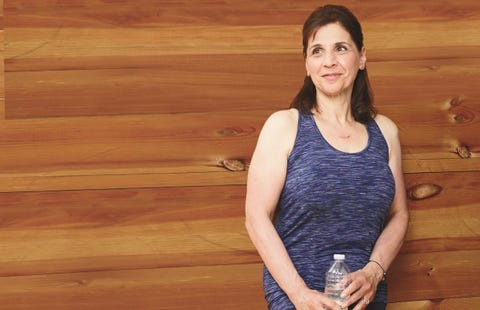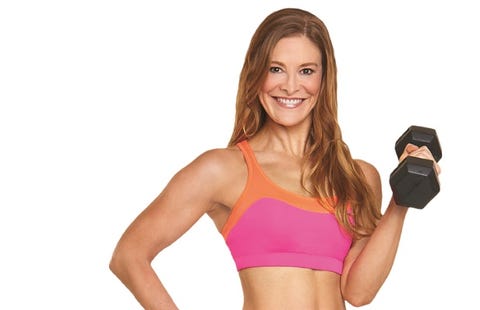28 Day Keto Diet Challenge
Across the nation, women age 40+ are transforming their bodies. They look younger. They feel younger. Want to be as strong, fit, and confident as these ladies? Take the 28-day Lift & Get Fit Challenge and tap into the life-changing power of lifting. Keep reading to learn how to join our team of thousands.

James Farrell
Will I really be able to lift that? Patricia Churchill thought as she watched a personal trainer up the weight on a leg-press machine. ALL that?
The petite 55-year-old Italian American had never been one to dodge a challenge, but at that moment, the 50 pounds her trainer was telling her to lever skyward might as well have been 50,000. She felt exhausted to the core. A recent round of physician's tests had turned up blank; thankfully, there was nothing medically wrong that was causing her to feel fatigued all the time. But after 5 years of riding a wicked roller coaster of menopausal hormones and also lugging around the 30 pounds she'd gained—all while dealing with insomnia—she didn't feel at all well. She had just retired from a taxing program analyst job that she'd done too conscientiously for 3 decades; now, feeling as tired she did, her dream of spending her life doing whatever she wanted whenever she felt like it—with lots of quality time spent with her husband and her poodle, Winston—wasn't looking too good. Her mom had died suddenly at 44 from a stroke, and her father was only in his 50s when he succumbed to lung cancer. Sure, she didn't smoke, but what if she just didn't have the longevity gene?
It was that thought that had propelled Churchill to the Quincy College Fitness Center in Massachusetts. A few weeks earlier, as she was leafing through a pile of mail at 5 AM, again unable to sleep, a brochure advertising the gym's "customized strength training" classes caught her eye amid the coupons and bills, and she thought, Why not? The gym was a mile from her house. The diets and cardio she'd tried on and off over the years hadn't stayed on her to-do list. At the very least, she'd be getting a plan to ease into exercise safely (and avoid these 6 common strength-training mistakes).
Now, inside the gym, she caught sight of her puffy-looking reflection in the mirror-lined walls and decided she'd made a huge mistake. She felt intensely awkward in her baggy T-shirt and sweats. The 5-pound dumbbells she'd envisioned were nowhere to be found. Looking down, she found herself fiddling with the space on her left hand where her wedding ring had been, before the extra pounds had forced it into a drawer. Looking up, she saw a sea of unfamiliar machines with which—according to her new trainer—she'd lift heavier and heavier loads. Every time she completed 2 sets of 12 reps of an exercise correctly and consecutively, he said, the weight would jump by 5%.

James Farrell
It occurred to her that she'd been headed toward this moment for a while: the moment when she'd either accept the image in the mirror as inevitable—Patty Churchill, aging fast—or fight for the life she wanted.
MORE:5 Best Anti-Aging Vitamins For Beautiful Skin
She climbed on the leg-press machine and began pushing. "I was surprised how much I could lift," she says in her soft-spoken New York accent, sounding quizzical to this day. Nine machines and 40 minutes later, her body and life would never be the same. "I just had no idea what I was capable of doing," she remembers of that moment. "Strength training with increasingly heavy weights became my fountain of youth."
Blame it on Michelle Obama's inspiring biceps or Olympic hammer-throw hopeful Amanda Bingson (who made headlines when her muscular bod appeared in the buff on a cover of ESPN Magazine's annual Body issue). Whatever the cause, lifting serious iron—long known by exercise scientists to be the secret of almost-eternal youth—is becoming a thing for women ages 40+. More than 87,000 women participated in the 2015 CrossFit Games Open, and more than a quarter of them were over 40. "When I started studying strength training in the '80s, most of the research participants were men," says Wayne Westcott, director of fitness research at Quincy College (where Churchill trains) and author of Strength Training Past 50. Now a whopping 70% are women. Their average age: 55. "Women are figuring out that staying with the same low weight for years will only get you so far," he says. "And they understand that what's really at stake here is their health and quality of life."
MORE:8 Reasons CrossFit Is Surprisingly Perfect For 40+
Churchill didn't need to deadlift 300 pounds or drink the CrossFit Kool-Aid to get the full anti-aging, body-morphing benefits that lifting promises. But she did have to trade in the 3-pound weights for 10-, 20-, and 30-pounders—and eventually more. Westcott and others call this approach "progressive strength training, where you continually lift heavier and heavier weights in order to rechallenge your body."
For women who want transformation, the need for progressive training is rooted in unequivocal muscle math. On average, starting in our late 20s, women lose 5 pounds of muscle every 10 years; after menopause, that muscle loss doubles, causing metabolism to get 3% slower every decade. Left unchecked, the end result is almost always the same: weight gain and weakness, with an increased risk of heart disease, diabetes, and cancer thrown on top for a little scientific cherry of doom and gloom.
So How Much Should You Lift?
You'll be able to tell you've got the weight right if your form starts to get "a wee bit sloppy" on the last 2 reps, says trainer Holly Perkins: "Once 12 reps are a breeze, it's time to move up." Increase in increments of 2.5 to 5 pounds for free weights and about 5% (of the total weight) for machines. And don't worry if the next increase is too hard to sustain for 12 full reps. "It's fine to start with 8 reps and build up to 12," says fitness researcher Wayne Westcott. Try challenging yourself to increase every 2 weeks and you'll be amazed at how quickly your body, health, and energy transform.
But progressive strength training can reverse the damage—and quickly. When Westcott's team recruited 1,619 men and women age 21 to 80 to follow the approach, phenomenal body changes happened to the 30+ participants. "In just 10 weeks, they replaced an average of 3 of the 5 pounds of muscle they had lost in the previous 10 years," says Westcott, who published his findings in the journal Physician and Sportsmedicine in 2009. And many women in his study were losing fat at the same time, without overhauling their diets or slugging through hours on the treadmill.
Churchill's experience is a textbook transformation. Within a month of sticking to her twice-a-week sessions, she lost 5 pounds of fat, and, as she gradually increased the weight she was lifting, her energy rose in tandem. "I felt like myself again. I couldn't believe how quickly my body responded," she recalls. Soon, rounded biceps, firmer calves, and sculpted shoulders started to emerge, and as the months went by, the extra weight fell off.

James Farrell
Of course, bringing your body back to a time when it was stronger and fitter requires a little more insight than blindly moving a few weights around. You need to add enough lean mass that your metabolism continues revving even when you are at rest. "Women spent decades buying into the myth that if they wanted to be smaller, they needed to do endless amounts of cardio," says Nia Shanks, a personal trainer based in Paducah, KY. But now the science is incontrovertible that "the muscles of a strength trainer burn 50% more calories at rest"—or an average of 100 calories a day—"than those of a runner or walker," says Westcott.
MORE:10 Exercises That Burn More Calories Than Running
As you add more lean mass, the denser and more devoid of fat that new muscle is and the more intense your transformation. Tighter muscle takes up less space (clothing win!) and is more efficient at doing everything from propelling you up stairs to burning fat and regulating blood sugar. And the only way to make muscle denser is to regularly increase the weight you're lifting.
"Every time you challenge your body with a heavier weight, you're creating more microtears in the muscle," says Holly Perkins, author of Lift to Get Lean and creator of the lifting community Women's Strength Nation. "As your body repairs those tiny tears with amino acids, your lean mass becomes tighter and more compact." Stay at the same low weight for too long and your new muscle gives a big yawn and a dismissive wave: "Is that all you've got?"
It's a huge misconception that lifting heavier weights will make you big and bulky.
Not working muscle as hard leads not only to fewer microtears but also to lower bone density, which can drop 20% just 5 to 7 years after menopause. "You can't build bone by sticking with 2- to 5-pound hand weights," says Westcott. "Heavier weights create more stress, which provides greater stimulus for building bones." Wielding heavier weights also seems to protect the brain and improve mental health. In one University of Illinois study of sedentary older adults, combining progressive strength training and aerobic exercise improved cognitive function significantly more than aerobic activity alone. In other studies, just 10 weeks of progressive strength training boosted tranquillity and reduced anxiety, fatigue, and depression. Churchill certainly got those quality-of-life benefits. "Within only 9 months of starting weight training, I was back to sleeping through the night," she says. "My brain wasn't as anxious, and my body was actually tired and ready to rest."
MORE:The 6 Healthiest Protein Powders For Your Smoothie
Lift & Get Fit—In 28 Days
If you're ready to transform your body but want both a plan and support as you go about it, the 28-Day Lift & Get Fit Challenge could be your answer. You'll learn the essentials of strength training, get familiar with new equipment, then accelerate your results. Here's how it works.
Step 1: Accept the Challenge
Enroll at RodaleU.com/liftandgetfitnow. There, for $9.99, you'll score access to the Women's Health challenge, tap into the community of other challenge takers, and get set up with the supersmart plan.
Step 2: Log On Daily
Starting January 1, you'll be able to access the program, including the daily tips, lessons, and workout videos that'll help you shed fat and gain strength and muscle. The more you check in, the faster you'll see those results.
Step 3: Make Friends
Use the chat boards at Rodale U to stay motivated, ask questions, and connect with our online community of women just like you who are lifting to get seriously strong.

Thomas MacDonald
Every step of the way, you'll be coached by top trainer Holly Perkins (pictured), a certified strength and conditioning specialist and author of Lift to Get Lean (Rodale, 2015), and by Women's Health fitness director Jen Ator.
So why has it taken so long for women to discover the miracle? It boils down to the fear of getting too big and to a mythical (and sexist) picture of how women should look—slim and small—and what they are capable of doing. "So many women stick to very light hand weights because they think they can't do more," says Shanks. "That's ridiculous—most of our purses weigh more, and so do the kids and grandkids we pick up."
Fortunately, beauty standards seem to be (slowly) changing, making room for a stronger female body ideal. "We're not afraid to lift heavy weights," said the First Lady's personal trainer, Cornell McClellan, in a workout video that Michelle Obama tweeted earlier this year as part of her #GimmeFive campaign. The next shot showed her lifting two 35-pound dumbbells through a perfect set of incline presses. It also helps that the "lift light, stay slim" myth is being exposed as biologically wrong. "It's a huge misconception that lifting heavy weights will build large, bulky muscles," says Westcott. "Most of us—men and women alike—simply don't have the genetics to develop really large muscles."
Westcott, Perkins, and other experts aren't as much militant about progressive weight lifting as they are ambitious for women. They would agree that yoga, Pilates, and good ol' fashioned floor exercises like planks, which use your own body weight as resistance, are a good introduction to strength training. But, says Perkins, "I want women to think bigger. You'll never be able to lift more than your body weight doing those."

James Farrell
Churchill, now 59, only knows that she can tackle any obstacle with the vigor of a woman 20 years younger. She now racks the leg-press machine at 215 pounds, and she isn't about to stop anytime soon. She's proud of the strength she's built—mentally and physically. Last winter, when Massachusetts was blanketed in 108 inches of heavy snow, Churchill and her husband didn't have to call for backup. Instead, they looked at each other, grabbed their shovels, and cleared their long, wide driveway all by themselves. Fitter, stronger Churchill took a few breaks, but she wasn't even winded.
This content is created and maintained by a third party, and imported onto this page to help users provide their email addresses. You may be able to find more information about this and similar content at piano.io
Source: https://www.prevention.com/fitness/a20493160/28-day-lift-to-get-fit-challenge/
0 Response to "28 Day Keto Diet Challenge"
Post a Comment